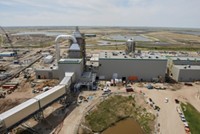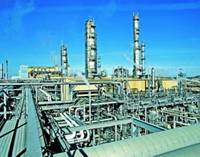Advertisement
Grab your lab coat. Let's get started
Welcome!
Welcome!
Create an account below to get 6 C&EN articles per month, receive newsletters and more - all free.
It seems this is your first time logging in online. Please enter the following information to continue.
As an ACS member you automatically get access to this site. All we need is few more details to create your reading experience.
Not you? Sign in with a different account.
Not you? Sign in with a different account.
ERROR 1
ERROR 1
ERROR 2
ERROR 2
ERROR 2
ERROR 2
ERROR 2
Password and Confirm password must match.
If you have an ACS member number, please enter it here so we can link this account to your membership. (optional)
ERROR 2
ACS values your privacy. By submitting your information, you are gaining access to C&EN and subscribing to our weekly newsletter. We use the information you provide to make your reading experience better, and we will never sell your data to third party members.
Environment
Coal gasification
April 3, 2006
| A version of this story appeared in
Volume 84, Issue 14
Glenn Hess wrote an interesting article on coal gasification (C&EN, Jan. 16, page 22), and I have no argument with the use of synthetic gas as a feedstock for various chemical processes. I do have concerns about the misperception that the coal-based syngas can be "used like natural gas" and with the term "pipeline-quality synthetic gas."
The heating value of natural gas is about 1,000 Btu/scf (standard cubic foot). Air-blown gasifiers produce a syngas at about 125 Btu/scf. To get the same energy one has to burn eight times as much, so burners would need to be changed to get the same heat release as with natural gas. The syngas from oxygen-blown gasifiers has a heating value of about 330 Btu/scf. Thus, you need to burn three times as much and still need different burners. Neither of these syngases are "pipeline quality" nor can they be "used like natural gas."
Suppose you would want to fire the syngas in a gas turbine designed for natural gas firing. The mass flow of the syngas needs to be three to eight times higher. The additional fuel mass flow added to the air mass flow developed by the gas turbine compressor has to pass through the combustor burners and then through the turbine (expander) sections of the gas turbine. Forcing a higher mass flow through the expander causes the pressure to rise at its inlet (and compressor outlet). This pressure increase reduces the stall margin of the compressor, creating a problem that can prevent operation.
This is remedied in syngas-fired gas turbines by increasing the flow area of the expander or reducing the flow capacity of the compressor and using special burners. Integrated coal gasification combined cycle (IGCC) plants provide living examples of the requirement to rematch the gas turbines in one way or another.
I have read claims that the huge fleet of natural-gas-fired gas turbines "stand ready" for future firing with syngas. This is also misleading, for the conversion to replace burners and either open the turbine sections or provide a means to close down the compressor section is very expensive. This would be great business for turbine suppliers. Now that I think of it, the "stand ready" claims have all come from major gas turbine manufacturers.
Jerry Burkett
Monessen, Pa.
I read with great interest the article, "Incentives Boost Coal Gasification." However, one of the most important pieces of history was not mentioned in the article. That is the Coolwater Coal Gasification Program at the Southern California Edison generating station in Daggett, Calif.
The 1,000 tons of coal per day, 100-net-MW plant was a full-commercial-size demonstration plant of IGCC power generation. From it, data were obtained to enable the construction of multi-hundred-MW plants.
This project was carried out by Texaco, Southern California Edison, Bechtel Power, General Electric, the Electric Power Research Institute, and the Japan Cool Water Program Partnership (Tokyo Electric, Central Research Institute of Electric Power Industry, Toshiba, and IHI). Empire State Electric Research and SOHIO were contributors.
The plant ran successfully from 1984 to 1988 and provided the base for today's commercial IGCC plants. The environmental data were and are superior to other technologies and are a matter of record. The people and companies who made it happen did so with a commitment to the future of clean energy for future generations.
Texaco had also demonstrated that organic waste, sewage sludge, petroleum coke, and anything organic could be cleanly gasified. ChevronTexaco has sold the gasification technology to General Electric. All of us who were involved with Coolwater cheer as we look forward to the large commercial plants coming on-line.
W. Raymond Siegart
Poughkeepsie, N.Y.
C&EN did not mention Dakota Gasification Co. in its story on coal gasification. They are currently producing 170 million standard cubic feet per day (scfd) of "synthetic natural gas" from 18,000 tons of North Dakota lignite from a plant that started in 1984. The plant also sequesters part of the carbon dioxide from the process by exporting 95 million scfd of high-pressure carbon dioxide for enhanced oil recovery. Total carbon dioxide production is about 240 million scfd.
It should be noted that the production of methane with a 4:1 H/C ratio from syngas yields more carbon dioxide than liquid fuel products with a H/C ratio approaching 2.
Edward A. White
Glenview, Ill.
The article on coal gasification in C&EN is encouraging but contains only part of the answer to achieving energy independence. An aggressive program to produce liquid hydrocarbon fuels is also urgently needed. The basic technology is available. The current and projected price of crude should provide more than ample incentive.
While many favor renewable sources of energy, it is likely that all of the other methods of energy generation in use or under investigation will not collectively have a major impact on our need for hydrocarbon fuels in the foreseeable future. Some will object to focusing so much effort on fuels that are seen to contribute to global warming. While we may be experiencing a global warming trend, it has happened before and there is little or no reliable information on the extent to which the burning of fossil fuels contributes to global warming or how much of an impact curtailing operations that generate greenhouse gases as called for by the Kyoto protocol will have on the apparent present global warming trend.
Robert L. Moison
Apple Valley, Minn.
The natural gas crisis is a natural (no pun intended) result of having outrun our domestic supply of that commodity. We are now dependent to an ever greater extent on gas imported either by pipeline from Canada or Mexico or as a liquefied natural gas (LNG) from almost anywhere in the world. These other sources are expensive, either because of foreign monopoly controls or because the technology is expensive. Even continental-shelf sources and deep-water sources such as those in the Gulf of Mexico will continue to be expensive compared with what we have become accustomed to.
I agree that coal gasification is a way to go, but I disagree with the premise that pipeline syngas could or should replace pipeline natural gas. For one thing, syngas is too valuable as a chemical feedstock to use as a purely thermal resource. (I assume that references to synthetic gas actually mean syngas rather than synthetic methane or natural gas. Although the conversion of syngas to methane is perfectly possible, it would be counterproductive to envision this as a source of chemical feedstock to be derived by reconverting methane back to syngas.) The other major objection to pipeline syngas is in the well-deserved reputation of city gas as an insidious poison.
Aside from pipeline gas potential, I believe that the future of syngas from coal is in its use for transport, in the form of methanol. I understand that at West Virginia University there are, or are pending, projects to convert coal to "synthetic crude," a gross mixture of aliphatic hydrocarbons similar to crude petroleum. I can readily see that big oil would love to have this alternative source of refinery stock on which they could practice their arts of reforming, fractionation, and blending. But to me, this is not the right way to go when, by a similar degree of processing, coal can be converted to an almost pure single product: methanol. Contrary to the evident conviction of those in Washington, D.C., methanol has many advantages as a replacement for gasoline and diesel as motor fuel.
J. R. D. McCormick
Wesley Hills, N.Y.




Join the conversation
Contact the reporter
Submit a Letter to the Editor for publication
Engage with us on Twitter